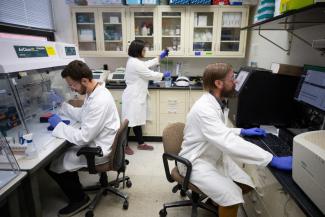NETL researchers have developed a biocatalyst with 99% efficiency that can convert carbon dioxide (CO2), a waste product of fossil energy industries that warms the planet and causes climate change, into acetate — an ingredient used in many products like cleaning supplies, textiles, and as a potential feedstock for biofuels.
Deployment of carbon management technologies is crucial to addressing the climate crisis and meeting the administration’s goal of a net-zero greenhouse gas emissions economy by 2050 while protecting existing industrial jobs and creating new ones. Biological conversion of CO2 is an attractive option to reduce carbon emissions and accelerate work toward a carbon-neutral economy.
According to the U.S. Department of Energy’s Bioenergy Technologies Office, biological conversion uses enzymes, microbes, and catalysts to make fuels and chemicals.
Biotechnology approaches have previously relied on photosynthesis — the chemical process that occurs in plants, algae, and some types of bacteria when they are exposed to sunlight and combine water and CO2 to give off oxygen — to convert CO2, but that process is less than 4% efficient.
As an alternative that is more efficient than photosynthesis, NETL researchers/inventors Daniel E. Ross, Djuna Gulliver, and Samuel Flett developed a biocatalyst approach to convert CO2 into acetate. Biocatalysts are natural substances that use enzymes from biological sources to improve the rate of chemical reactions. NETL has filed for a patent on the technology.
Other processes for CO2 conversion using biocatalysts have been developed, but the biocatalyst developed at NETL has a unique adaptability to feedstocks and resistance to contamination challenges, making it a promising target for large-scale deployment.
NETL’s Djuna Gulliver, Ph.D., explained that the biocatalyst is made up of a unique microbial community that adapts to changes in the raw materials — CO2, syngas, formate, and methanol — used in the process as well as other conditions.
“That adaptability makes the biocatalyst very robust to environmental challenges,” Gulliver said. “As a result, the technology is very well suited for widespread field deployment.”
Microbial communities have been described as groups of microorganisms — organisms that can be seen only through a microscope such as bacteria, protozoa, algae, and fungi — that share a common living space. The microbial populations that form the community can interact in different ways.
Flett said that adaptability of the NETL biocatalyst approach makes it a good way to convert CO2 found in waste gas streams from ethanol plants, syngas production and blue hydrogen production — hydrogen produced from natural gas.
Ross added that unlike conventional non-biological CO2 utilization pathways that require high energy and deliver low yields, the NETL biocatalyst technology requires little energy input and converts all CO2 into a useable product.
Acetate is a particularly attractive product. Growing demand from the paints and coatings industry and flexible packaging sectors are anticipated to be the main driver of market expansion. In addition, acetate’s flexibility and environmental friendliness are driving the market for acetate.
According to research by Utah State University, “Initially invented in Europe as a varnish for airplane wings, acetate was first produced in the United States in 1924 making it the second oldest manufactured fiber.”
Today, acetate is used for in a wide range of products like tool handles, eyeglass frames, and as a component of many medical and food industry products.
NETL’s carbon conversion research identifies and develops new and improved materials, equipment, and processes that produce value-added goods using CO2 or CO as a feedstock. Products can include fuels, chemicals, agricultural products, animal feed, building materials and other products. The development of technologies that lead to revenue-generating products can help support broader carbon emissions reduction strategies and lead to more sustainable power generation and industrial and agricultural practices.
NETL drives innovation and delivers technological solutions for an environmentally sustainable and prosperous energy future. By using its world-class talent and research facilities, NETL is ensuring affordable, abundant, and reliable energy that drives a robust economy and national security, while developing technologies to manage carbon across the full life cycle, enabling environmental sustainability for all Americans.




